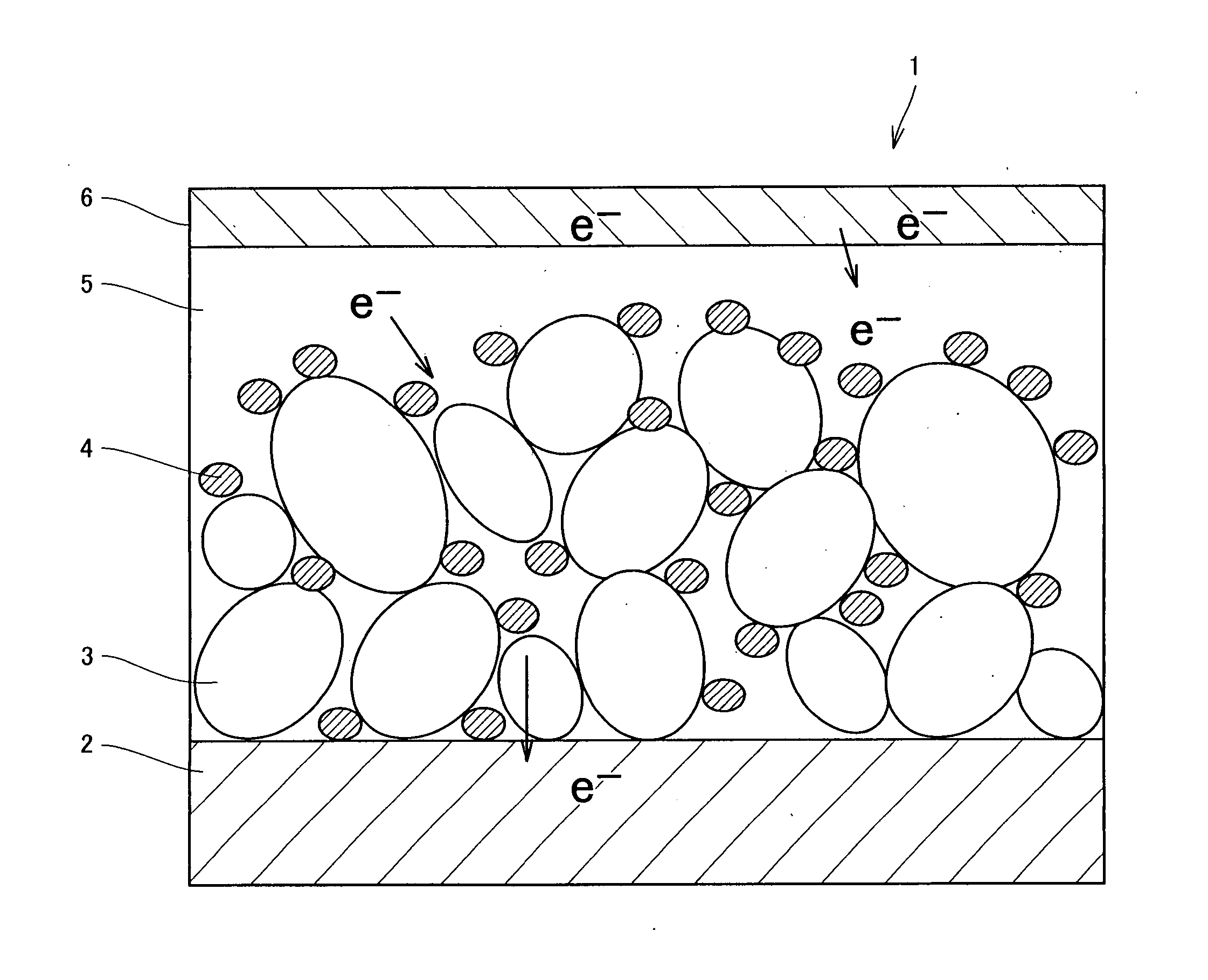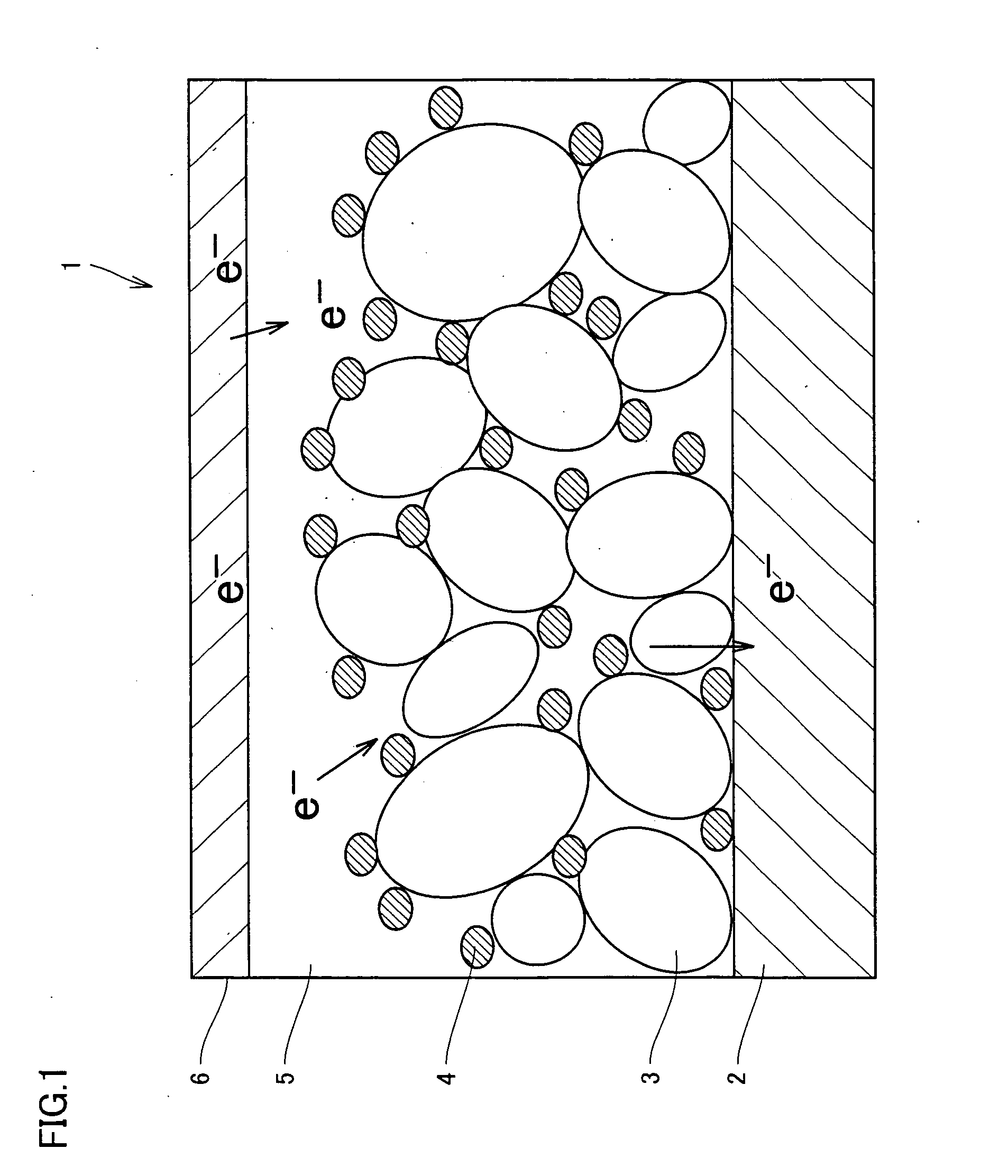Photosensitizer, semiconductor electrode, and photoelectric conversion device
- Summary
- Abstract
- Description
- Claims
- Application Information
AI Technical Summary
Benefits of technology
Problems solved by technology
Method used
Image
Examples
example 1
[0080] Initially, 0.71 mmol guanidine hydrochloride (manufactured by Aldrich, chemical formula: CH6N3Cl) was dissolved in 10 ml pure water, to prepare a solution 1. Meanwhile, 0.35 mmol cis-dithiocyanato-bis(4,4′-dicarboxyl-2,2′-bipyridine) ruthenium (II) complex (manufactured by Solaronix, product name: Ru535, commonly called N3 dye) which represents bipyridine ruthenium complex forming molecular structure D in the photosensitizer shown in General Formula (X) was added to 10 ml pure water. While stirring this solution, 0.1 mol / l sodium hydroxide (NaOH) solution was gradually dropped until N3 dye was completely dissolved, to prepare a solution 2. Solution 1 and solution 2 prepared as above were mixed, and the resultant solution was left for reaction for 30 minutes at a temperature of 70° C. in a dark place. After cooled to a room temperature, the reaction solution was filtered. The resultant solid was dried under vacuum, to obtain the compound shown in Chemical Formula b above.
[008...
example 2
[0082] The compound shown in Chemical Formula c above was obtained as in Example 1, except that commercially available trithiocyanato(4,4′,4″-tricarboxy-2,2′:6′,2″-terpyridine) ruthenium (II) tri-tetrabutylammonium complex of 0.23 mmol (manufactured by Solaronix, product name: N620-1H3TBA, commonly called black dye) representing terpyridine ruthenium complex was used as the material for forming molecular structure D in the photosensitizer shown in General Formula (X), instead of N3 dye.
[0083] A result of analysis of the product was as follows. Compound c: C24H27N15O6RuS3; yield: 70%; calculated value: C=35.20, H=3.32, N=25.66; measured value: C=34.80, H=3.42, N=25.32; and MS (ESIMS): m / z=818.1 (M−H)−, 379.0 [M−H-(guanidinium)]2−, 232.6 [M-H-2 (guanidinium)]3−.
example 3
[0084] The compound shown in Chemical Formula d above was obtained as in Example 1, except that 0.35 mmol thiocyanato-1,1,1-trifluoropentane-2,4-dionato(4,4′,4″-tricarboxy-2,2′:6′,2″-terpyridine) ruthenium (II) complex (synthesized in accordance with the method described in Japanese Patent Laying-Open No. 2003-212851) representing terpyridine ruthenium complex was used as the material for forming molecular structure D in the photosensitizer shown in General Formula (X), instead of N3 dye.
[0085] A result of analysis of the product was as follows. Compound d: C26H28F3N10O8RuS; yield: 70%; calculated value: C=39.10, H=3.53, N=17.54; measured value: C=39.72, H=3.42, N=17.23; and MS (ESIMS): m / z=798.1 (M−H)−, 369.0 [M−H-(guanidinium)]2−, 226.0 [M−H-2 (guanidinium)]3−.
PUM
 Login to View More
Login to View More Abstract
Description
Claims
Application Information
 Login to View More
Login to View More - R&D Engineer
- R&D Manager
- IP Professional
- Industry Leading Data Capabilities
- Powerful AI technology
- Patent DNA Extraction
Browse by: Latest US Patents, China's latest patents, Technical Efficacy Thesaurus, Application Domain, Technology Topic, Popular Technical Reports.
© 2024 PatSnap. All rights reserved.Legal|Privacy policy|Modern Slavery Act Transparency Statement|Sitemap|About US| Contact US: help@patsnap.com










